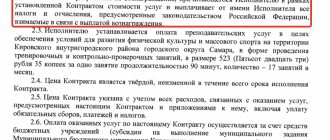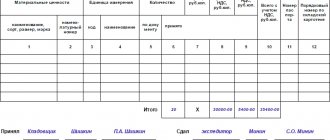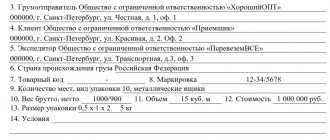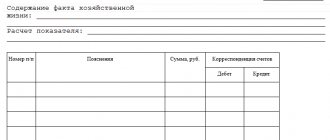Property damage report is a document that records damage caused to inventory items belonging to the enterprise. In this case, the intentionality or unintentionality of the actions that caused the damage to the property does not play a role - the act is drawn up regardless of these circumstances.
- Form and sample
- Online viewing
- Free download
- Safely
FILES
Examples of property damage acts:
- when an apartment or office is flooded - when performing any work - when delivering or transporting goods - namely documents
Why is the act needed?
The report refers to the primary documentation of the company, and, being an unconditional written proof of the damage/breakage caused, subsequently becomes the basis for writing off damaged inventory items or sending them for repair.
An employee directly involved in causing damage to company property may be subject to disciplinary action based on this document. It is assigned depending on how seriously the organization’s property was damaged:
- comment,
- rebuke,
- layoffs,
- sometimes we even talk about criminal prosecution.
All the nuances of the event are taken into account here, including the presence of intent. In addition, on the basis of the act, the management of the enterprise has the right to demand compensation for material damage from the culprit.
Who signs the completed act?
In conclusion, the TORG-15 act is signed by all members of the commission, including the employee responsible for storing inventory items. After reading the document, the head of the company signs his visa and decides on subsequent actions in relation to the product (write off or discount) and determines which employee is to blame for what happened.
As a rule, the loss of consumer properties of a product occurs due to mismanagement of employees, so damages are recovered from those responsible.
Who draws up the act
The act can be drawn up by any employee of the organization whose job responsibilities include this function. This could be the head of a structural unit, a lawyer, a secretary, or simply a materially responsible person.
When creating the act, other company employees must be present and act as witnesses to the damage caused. Thus, a special commission is formed consisting of at least three people , preferably workers from different departments.
If the damaged property relates to high-tech equipment or devices, in order to more accurately diagnose the damage, a specialist from an engineering or service department operating within the enterprise or a third-party expert should be involved in drawing up a report.
First page of the act
The act of write-off of goods in the TORG-16 form begins with a reference to Goskomstat Resolution No. 132 of December 25, 1998 in the right-left corner of the page. It was this resolution that established this form as a unified form for writing off goods. It has been used for a long time, and it still remains relevant.
After the link to the legislative framework there is a miniature table with codes. The OKPO code is already indicated, it remains unchanged when using this form - 0330216. It is already printed. In addition, it must contain the code according to OKPO, the type of activity according to OKDP and the coding of the type of operation. To the left of the code table there is space to indicate the full name of the organization and if there is a structural unit. The latter can be a warehouse, workshop, storeroom, etc.
An important point is the basis for drawing up the act. One column is allocated for it at the top of the document. In addition to the name of the document, it must contain its number and date of signing.
Since during the write-off of goods the risk of fraud on the part of employees increases, on each write-off act there is a separate space for the approval of the manager. The completed act must bear the signature of the manager with a transcript, position and date of issue. The act is assigned a number. It and the date of signing are placed immediately after the title of the document.
Drawing up an act: main points
Today there is no standard unified sample act, so the document can be written in any form or according to a template that operates within the company. At the same time, there is a number of certain information that must be included in it:
- Date, number and place of writing, name of organization.
- In the main part you should indicate
- the essence of the damage caused,
name and quantity of damaged inventory items,
- approximate amount of damage.
- You also need to enter
- information about the culprit: his position, last name, first name and patronymic
and the reasons why property was damaged (this point is very important for determining the exact degree of guilt and imposing a fair punishment).
- Next in the act you should write conclusions about the consequences of the damage caused to the property: whether this property can be repaired or whether it needs to be written off.
- If there are any additional supporting documents, they must be added to the act, marked as a separate item.
If there are several items, it is better to arrange all the data in the form of a table.
If the perpetrators cannot be identified (for example, in cases of damage as a result of force majeure: disasters, floods, etc.), this must be indicated.
Registration of an act of damage, damage, scrap of inventory items
Filled out by whom?
To carry out an inventory and draw up a report on damage, scrap, and damage to goods, the head of the organization issues an order to create a special commission (at least three people), which includes a representative of the administration and a financially responsible person. The document is filled out by one of the commission members in triplicate.
Content
To draw up a document, you can take a unified form in the TORG-15 form or develop your own template based on it. Practice shows that a unified form is easy to fill out and understandable to representatives of regulatory authorities, so it is better to use the approved TORG-15 form. Let's look at the order of filling it out:
- At the top of the document the full name of the organization is indicated, indicating the legal address, telephone number and structural unit in which the inventory is carried out.
- Below is information about the full name of the supplier, indicating its full details, including bank details (current account, BIC, checkpoint).
- In special columns the document number and the date of its preparation are indicated.
- Title of the document: “Act on damage, scrap, destruction of inventory items.”
- A table consisting of fifteen columns is filled in:
- The name and characteristics are written down. For example, “Gingerbread “Mint”.
- Product code.
- Unit of measurement, name. For example, "pieces."
- Unit of measurement, code OKEY (all-Russian measurement code).
- Product article.
- Variety (category). For example, “1st grade”.
- Quantity (mass).
- The accounting price per unit of goods. For example, "75".
- Total amount for all goods. For example, "750".
- Then there is a section that includes four columns, which indicate:
- quantity (weight) of goods;
- new price (cost after markdown);
- total cost;
- markdown amount (the difference between the total amount for the product before and after the price reduction).
- The 14th column indicates the discount percentage.
- The last column indicates the characteristics of the defect. For example, “packaging violation”.
- The reason for the loss is indicated below the table. If the cause is technological processes or physical conditions, then in the line below, data on the perpetrators is not entered, otherwise the surname, first name, patronymic and position of the person responsible for the fight, scrap or damage to goods are indicated.
- On the back of the form, fill out the section entitled “Credit scrap (scrap).” It contains data about the product if it is impossible to further sell or use it.
Attention! When filling out, you must fully indicate the name of material assets, information about the supplier, the reasons and circumstances that led to damage to the goods.
Are mistakes acceptable?
The document must be drawn up without blots or errors. In case of corrections, it is better to reissue it. Calculations of markdowns or write-offs of goods must be made correctly, otherwise this will be the basis for the tax service to refuse to include expenses in taxable profit.
In case of errors in filling out and calculations, recovery of damages from the guilty party will be impossible.
Who signs?
The document is drawn up in triplicate and signed by all members of the commission and the financially responsible person. At the bottom of the act, under the calculations made, after checking the correctness of filling, the chief accountant signs. The papers are handed over to the manager, who, after making a decision, puts his signature on the front side of the act at the top of the form near the number and date of preparation.
Registration of the act. What to pay attention to
When drawing up an act, as well as when writing it, you can be guided by your own considerations, since the law does not impose any special requirements on this parameter. The act can be written on a simple blank sheet of paper or on the organization’s letterhead. You can enter information by hand (with any ballpoint pen, but not a pencil) or type it on a computer.
Important! The act must contain the signatures of its immediate compiler and the employees present - their autographs will indicate that all the information entered in the document is correct.
It is advisable to obtain the signature of the perpetrator of property damage, but if he refuses to sign the document, you can make a corresponding note directly in the act or draw up a separate act of refusal to sign the act.
It is not necessary to certify the form of the act with a seal - since 2016, the use of stamped products in enterprises and organizations is necessary only in cases where this is enshrined in the internal regulatory documents of the company.
The act is drawn up in two copies :
- one remains in the company and is sent to the accounting department to write off property or allocate money for repair work,
- the second is transferred to the employee who caused the damage.
If necessary, you can make additional copies of the act.
How to draw up a TORG-15 act: sample filling and rules
To draw up TORG-15, a special commission is created, composed of members approved by the director of the company. It must include a representative of the enterprise administration, a person financially responsible for the safety of goods, and, if necessary, a representative of the sanitary inspection.
The visa approval of the director of the company must be on the front side of the act. The TORG-15 act is filled out in 3 identical copies, one of which remains in the structural unit, the other is sent to the accountant for display in accounting and withholding the damage from the salary of the guilty employee, and the third is transferred to the person responsible for causing the damage.
When filling out TORG-15, you should pay attention to filling out some points. Thus, the code for the reason for damage/breakage/scrap may not be included in the report if the company does not use an internal coding system. The document must indicate the reason for writing off the damaged goods or marking them down.
For information on how you can organize accounting in trade, read the article “Trading goods with and without VAT (nuances).”
Spoiled (damaged) goods should be listed, indicating their name, main characteristics, quantity and accounting value before and after the markdown. The guilty person (if it is possible to identify him) and his position must also be named.
The final part of TORG-15 contains the text of the manager’s order on the further fate of damaged (damaged) inventory items. Thus, the need for their disposal may be indicated. In addition, you should provide the exact amount of damage and the details of the person at whose expense it will be compensated.
Act on damage to property due to flooding of an apartment or office
Flooding of apartments in multi-storey buildings is especially common. Offices can also be subject to this problem, as well as detached residential buildings. Even if there are no careless neighbors above the premises, flooding cannot be ruled out. There can always be a water supply failure, a breakthrough in the water heating system, a roof leak, etc.
One of the important procedural actions necessary for subsequent compensation for damage is drawing up an act of damage to property. It is compiled by representatives of the company servicing the building (its emergency service) called to the site of flooding with the participation of the injured party. This must be done within the first 12 hours after calling the authorized persons. If company representatives do not appear on time, it is permissible to draw up the act without them, inviting uninterested outsiders to the commission. In this case, the management company should be sent a written notice, and the act should indicate that it was informed, but did not participate in drawing up the act due to failure to appear when called.
If the room is flooded due to the fault of a specific person, for example, a neighbor above, he also participates in drawing up the act.
IMPORTANT! If the culprit was not identified, he could not be invited, or he refused, this should be reflected in the text of the act.
This document should reflect the following data:
- date and exact time of establishment of the fact of flooding;
- address of the location of the flooded premises;
- localization of water masses;
- the reason that water entered the apartment or office;
- the culprit of the flood (if identified);
- mention of witnesses (if there were any)
- description of water damage (based on visual inspection).
ATTENTION! When describing the damage, you need to indicate not only the condition of the ceiling, walls, floor, but also damage to furniture, papers and other property located in the room. This can be done in the form of a defect sheet, inventory, etc.
The remaining parts of the document (header, date, signatures of commission members) are drawn up according to the basic principles of office work. The laws do not provide for a strict form for the document.
ACT No. 11 of inspection of residential premises located at the address: Nizhny Novgorod, st. Vaneeva, 17, apt. 21 dated August 19, 2017
Based on the application (incoming number 134 dated 08/19/2017) from gr. Derevyansky N.Yu. regarding the flooding of the apartment, a commission was formed consisting of:
- Head of Housing Department No. 2 Morshansky A.P.;
- engineer of housing department No. 2 Peresvetova T.A.;
- foreman of housing department No. 2 Nikodimova O.L.
At the time of the inspection, the person responsible for the flooding could not be identified.
The commission conducted an inspection of the residential premises at the specified address.
At the time of the inspection (08/19/2017 at 16:30), the following damage due to flooding was established.
A living room with an area of 26 sq.m. was damaged:
- on a ceiling painted with water-based paint, water stains and stains are located over the entire surface;
- walls covered with non-woven wallpaper have streaks along the entire perimeter and are partially peeling off;
- the floor (laminate) has swelling at the joints;
- The door is wooden, painted, swollen and does not close.
The furniture wall in the room was damaged (swollen along the surface adjacent to the wall) and the Sony KDL-32WE613 TV (out of order).
The flooding occurred on August 19, 2017 at 15:45. The following rectification work was carried out:
- the hot water riser was closed at 16:00;
- hot water supply riser replaced (08/23/2017)
The commission's conclusions: the cause of the flooding is a failure of the hot water supply pipeline (pipe rupture).
Members of the commission: Head of Housing Department No. 2 /Morshansky/ A.P. Morshansky Housing Department Engineer No. 2 /Peresvetova/ T.A. Peresvetova Master of housing department No. 2 /Nikodimov/ O.L.Nikodimov
The act was reviewed by: owner of apartment No. 21 /Derevyansky/ N.Yu. Derevyansky
Act on damage to property when performing any work
When unintentional damage to property occurs due to some life situations, for example, work, the resulting damage must be compensated somehow. If we are talking about the property of an enterprise, then damaged items must be written off or repaired. The person responsible for damage may be subject to administrative or financial liability. The basis for these procedures is a regulatory document - an act on damaged property.
At an enterprise, such an act can be drawn up by an authorized financially responsible employee. The commission must include at least 3 employees of the organization.
ATTENTION! If technically complex equipment is damaged, then a competent specialist should be included in the commission or an expert should be invited.
How to draw up an act
There is no unified form of the act, but it provides for some points that are mandatory to establish the fact of damage to property. As with any official document, the act must include:
- name of the organization (or use letterhead);
- act number;
- Date of preparation;
- signatures of the commission members and the person who drew up the act.
The main part of the act, which determines its “specialization,” consists of the following points.
- Description of damage:
- what is the damage caused to the property;
- what material assets were damaged (name, inventory number, quantity);
- the approximate amount of damage.
- Information about the culprit of the damage. If it cannot be clearly established, this should be noted in the report. The person responsible must be indicated:
- his name, position;
- the reasons why the damage was caused or allowed to occur;
- information about witnesses (if any).
- Consequences of damage: it is clarified whether the damaged property can be repaired or needs to be written off.
- Applications. They may be additional sources confirming the harm caused, for example, recordings from surveillance cameras, etc.
BytRemontService LLC, Yekaterinburg 08/22/2017
ACT No. 5 On damage to property
In this document, I, the head of the sales department, Anatoly Ivanovich Levanevsky, established that on August 22, 2017, an employee of the administrative and economic department, Antonina Petrovna Revakova, during routine cleaning, unintentionally damaged property belonging to BytRemontServis LLC: LG 34UC79G-B LCD monitor ( pushed off the table onto the floor).
The incident was witnessed by the manager of the sales department, Roman Konstantinovich Sokolenko.
Cause of damage: carelessness when wiping off dust.
The monitor needs repair - replacement of the display matrix, at an estimated cost of 1200 rubles.
Head of Sales Department /Levanevsky/ A.I. Levanevsky Sales Department Manager /Sokolenko/ R.K. Sokolenko
An employee of the administrative and economic service /Revakova/ A.P. was familiarized with the act. Revakova
Act on damage to property during delivery or transportation of goods
Even if delivery is carried out with all due care, damage to the goods transported cannot be ruled out. Without delving into the reasons and the search for the culprits, it should be noted that the cost of damaged or damaged cargo must be compensated - through insurance, the financial liability of the guilty party, or in another way. The damaged goods themselves must be included in losses when summing up the balance sheet. To do this, you need a documentary basis - an act of damage to property during cargo transportation.
If such problems are discovered upon receipt of the goods, the buyer (recipient), together with the person who delivered the goods (forwarder, courier, driver, company representative), must find out important details that will be mentioned in the act:
- name of the damaged product
- the amount of spoiled cargo in standard units of measurement (pieces, kg, meters, etc.);
- the nature of external damage to the packaging;
- whether the goods were properly packaged, whether there is the necessary marking on the packaging.
IMPORTANT! The act must be drawn up immediately after delivery, in the presence of the party who delivered it.
In addition to these details, the act should indicate:
- place of delivery and destination of the cargo;
- data about all parties: sender, carrier, recipient;
- delivery time (according to plan and actual);
- description of goods (in accordance with the documentation);
- what the cargo looked like upon arrival;
- approximate amount of damage.
The findings should establish the cause of the damage and the person responsible for it (if possible).
To ensure reliability, at least two more people must be invited as members of the commission. They can be qualified workers who can assess the damage and certify the damage, for example, an accountant of the recipient organization, a lawyer, a supply manager, etc.
It is advisable to attach additional documentary evidence: photos of the cargo, video recording from the carrier’s car, written evidence from eyewitnesses, etc.
You need to make at least 3 copies of the act:
- for the supplier of goods;
- for the person or company who carried out the transportation;
- for the recipient of the goods.
ACT No. 12 On damage to delivered cargo
Penza, August 17, 2017
The receiver of the goods, representative of Leto LLC Zarubin V.V., drew up this report on the damage to the delivered goods upon receipt.
- Sender of the goods: LLC "Our Lemonade".
- Recipient of the goods: Leto LLC.
- Transportation of goods was carried out by the carrier company Magistral LLC.
- Product description: 30 plastic boxes of Bell lemonade in glass bottles with a capacity of 0.33 l, 12 bottles per box.
- Value of the goods according to documents: 21,510 rubles.
- Consignment note No. 000045278 dated 08/17/2017
- Cargo departure point: Penza, st. Belyakova, 19, warehouse 1.
- Cargo destination: Penza, st. Austrian, 68, warehouse 2.
- Transportation time: estimated - from 12:00 to 14:00 (2 hours), in fact - from 12:30 to 13:45 (1 hour 15 minutes).
- Description of cargo received: upon delivery, 30 plastic boxes of lemonade were received, 12 bottles each, including 2 damaged boxes and 18 broken bottles.
- The packaging has not been opened, the seals are intact.
Applications:
- photographs of damaged boxes;
- photographs of broken bottles.
The established cause of cargo damage: excessive speed during delivery, which led to an accident - violation of transportation standards.
The recipient of the cargo, Leto LLC, is required to reimburse the amount of 2,000 rubles.
Members of the commission Head of the reception point of Leto LLC /Zarubin/ V.V. Zarubin Chief accountant of Leto LLC /Nezlobina/ E.P. Nezlobina Head of Warehouse No. 1 Leto LLC /Petukhov/ G.K. Petukhov
The driver of Magistral LLC /Rukavichkin/ R.A. has been familiarized with the act. Rukavichkin





